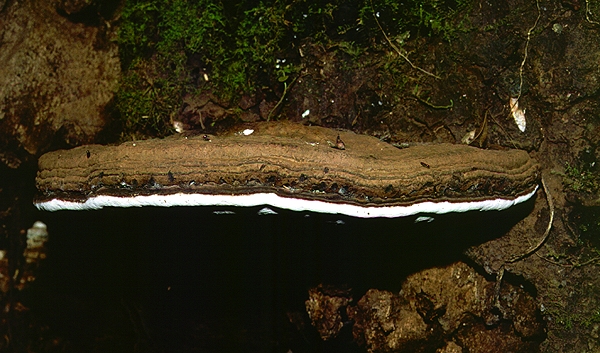
Ganoderma aff. applanatum (Pers. ex Wallr.) Pat.

Common name: Artists Fungus, from the rapid discoloration of the pores when touched.
Description: This fungus forms large, bracket-shaped caps directly on wood. The brackets are normally up to 30 cm in diameter but some enormous brackets are over 50 cm. The upper surface is brown (often discoloured green by algae) and covered by concentric ridges that produce a surface that slopes outwards to the bracket margins. The context is woody and dark brown. The pores are creamy white, quite small, and immediately discolour brown when touched. Old or inactive pore surfaces are a shade of brown. The brackets are perennial, and the ridges on the upper surface represent periods of growth. Usually the ridges are produced annually but sometimes there can be two growth periods per year if climatic conditions are suitable. In this way, large brackets can be estimated to be well over 20 years old. The spores are brown and are often produced in such large quantities that the surfaces or vegetation under the bracket is covered in a dusty brown deposit.
Spores 68.5 × 56.5 µm, ellipsoidal, brown and have a very thick spore wall, the surface of which is finely pitted.
Substratum: Trunks of living trees or fallen logs. The fungus attacks the heartwood of the tree and sooner or later causes it to fall. It may then continue to grow and fruit prolifically on the fallen log. Brackets may appear singly or as several together, sometimes in tiers up a living trunk.
Distribution: This fungus (or a complex of very similar species) is common in all eastern mainland States and in Tasmania.
Notes: It is not certain whether the species shown here is Ganoderma applanatum or a closely related species such as G. australe. Considerable work is still in progress sorting out the various taxa in this difficult group. However, there is no doubt that the fungus described here is close to the European Ganoderma applanatum. Work done by the European polypore specialist L.Ryvarden seems to indicate that both G. australe and G. applanatum occur in Australia. These two species are considered to be fairly destructive tree parasites in forestry where they produce a white rot of the tree heartwood.

